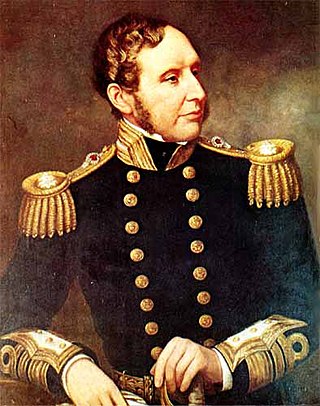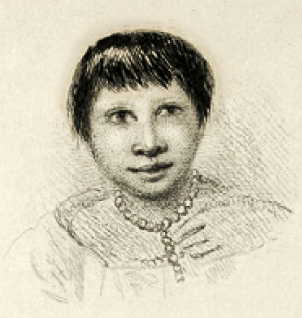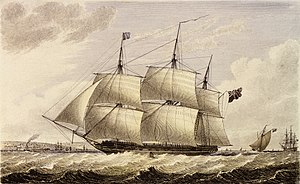
HMS Beagle was a Cherokee-class 10-gun brig-sloop of the Royal Navy, one of more than 100 ships of this class. The vessel, constructed at a cost of £7,803, was launched on 11 May 1820 from the Woolwich Dockyard on the River Thames. Later reports say the ship took part in celebrations of the coronation of King George IV of the United Kingdom, passing under the old London Bridge, and was the first rigged man-of-war afloat upriver of the bridge. There was no immediate need for Beagle, so she "lay in ordinary", moored afloat but without masts or rigging. She was then adapted as a survey barque and took part in three survey expeditions.

Vice-Admiral Robert FitzRoy was an English officer of the Royal Navy and a scientist. He achieved lasting fame as the captain of HMS Beagle during Charles Darwin's famous voyage, FitzRoy's second expedition to Tierra del Fuego and the Southern Cone.

The Voyage of the Beagle is the title most commonly given to the book written by Charles Darwin and published in 1839 as his Journal and Remarks, bringing him considerable fame and respect. This was the third volume of The Narrative of the Voyages of H.M. Ships Adventure and Beagle, the other volumes of which were written or edited by the commanders of the ships. Journal and Remarks covers Darwin's part in the second survey expedition of the ship HMS Beagle. Due to the popularity of Darwin's account, the publisher reissued it later in 1839 as Darwin's Journal of Researches, and the revised second edition published in 1845 used this title. A republication of the book in 1905 introduced the title The Voyage of the "Beagle", by which it is now best known.

Sir William Snow Harris was a British physician and electrical researcher, nicknamed Thunder-and-Lightning Harris, and noted for his invention of a successful system of lightning conductors for ships. It took many years of campaigning, research and successful testing before the British Royal Navy changed to Harris's conductors from their previous less effective system. One of the successful test vessels was HMS Beagle which survived lightning strikes unharmed on her famous voyage with Charles Darwin.
The following ships of the Royal Navy were assigned the name Calypso, after Calypso, a sea nymph in Greek mythology:

The second voyage of HMS Beagle, from 27 December 1831 to 2 October 1836, was the second survey expedition of HMS Beagle, made under her newest commander, Robert FitzRoy. FitzRoy had thought of the advantages of having someone onboard who could investigate geology, and sought a naturalist to accompany them as a supernumerary. At the age of 22, the graduate Charles Darwin hoped to see the tropics before becoming a parson, and accepted the opportunity. He was greatly influenced by reading Charles Lyell's Principles of Geology during the voyage. By the end of the expedition, Darwin had made his name as a geologist and fossil collector, and the publication of his journal gave him wide renown as a writer.

Rear-Admiral Lord Adolphus FitzClarence was a British Royal Navy officer and illegitimate son of Prince William, the future William IV, and his mistress Dorothea Jordan. FitzClarence joined the navy in 1813. In the following year he joined a fourth rate which saw service in the War of 1812, including in the unsuccessful blockade and chase of USS Constitution. FitzClarence saw frequent service in the Mediterranean Sea. Coming under the patronage of Rear-Admiral Sir Thomas Fremantle, FitzClarence received further naval education from Commander William Henry Smyth and served in the Ionian Islands upholding British neutrality in the Greek War of Independence.

The Cherokee class was a class of brig-sloops of the Royal Navy, mounting ten guns. Brig-sloops were sloops-of-war with two masts rather than the three masts of ship sloops. Orders for 115 vessels were placed, including five which were cancelled and six for which the orders were replaced by ones for equivalent steam-powered paddle vessels.

HMS Bermuda was an 18-gun sloop of the Royal Navy.

The Structure and Distribution of Coral Reefs, Being the first part of the geology of the voyage of the Beagle, under the command of Capt. Fitzroy, R.N. during the years 1832 to 1836, was published in 1842 as Charles Darwin's first monograph, and set out his theory of the formation of coral reefs and atolls. He conceived of the idea during the voyage of the Beagle while still in South America, before he had seen a coral island, and wrote it out as HMS Beagle crossed the Pacific Ocean, completing his draft by November 1835. At the time there was great scientific interest in the way that coral reefs formed, and Captain Robert FitzRoy's orders from the Admiralty included the investigation of an atoll as an important scientific aim of the voyage. FitzRoy chose to survey the Keeling Islands in the Indian Ocean. The results supported Darwin's theory that the various types of coral reefs and atolls could be explained by uplift and subsidence of vast areas of the Earth's crust under the oceans.

HMS Persian was a Cruizer-class brig-sloop built by Daniel List and launched at Cowes in 1809. She captured two privateers before she wrecked in 1813.

HMS Blonde was a 46-gun modified Apollo-class fifth-rate frigate of 1,103 tons burthen. She undertook an important voyage to the Pacific Ocean in 1824. She was used for harbour service from 1850 and was renamed HMS Calypso in 1870, before being sold in 1895.

The 1835 Concepción earthquake occurred near the neighboring cities of Concepción and Talcahuano in Chile on 20 February at 11:30 local time and has an estimated magnitude of about 8.5 . The earthquake triggered a tsunami which caused the destruction of Talcahuano. A total of at least 50 people died from the effects of the earthquake and the tsunami. The earthquake caused damage from San Fernando in the north to Osorno in the south. It was felt over a still wider area from Copiapó in the north to the island of Chiloe in the south and as far west as the Juan Fernández Islands.

A nautical chronometer made by Thomas Earnshaw (1749–1828), and once part of the equipment of HMS Beagle, the ship that carried Charles Darwin on his voyage around the world, is held in the British Museum. The chronometer was the subject of one episode of the BBC's series A History of the World in 100 Objects.

HMS Arab was the French 20-gun corvette Jean Bart, launched in 1793. The British captured her in 1795 and the Royal Navy took her into service. She was wrecked in 1796.

HMS Sibyl was a 28-gun Enterprise-class sixth-rate frigate of the Royal Navy. Sibyl was renamed HMS Garland in 1795.
Pringle Stokes was a British naval officer who served in HMS Owen Glendower on a voyage around Cape Horn to the Pacific coast of South America, and on the West African coast fighting the slave trade. He then commanded HMS Beagle on its first voyage of exploration in the south Atlantic. After two years in command of the Beagle, depressed by the harsh winter conditions of the Strait of Magellan, he committed suicide.
HMS Plumper was launched in 1807. She captured three small American privateers early in the War of 1812 but was wrecked in December 1812.
HMS Volador was an ex-Spanish prize that the Royal Navy acquired in 1807 in the West Indies. Commander Francis George Dickens commissioned her.

Yokcushlu was a Kawésqar woman from the western Tierra del Fuego. In 1830, at the age of nine, she was taken hostage by the crew of the British vessel HMS Beagle and renamed "Fuegia Basket". Robert FitzRoy, captain of the Beagle, initially intended to trade her for a stolen boat. He later decided to take her and three other Fuegians, "York Minster", "Boat Memory", and "Jemmy Button", to England where they could be educated and taught Christianity so that they might return to "civilise" their people and serve as interpreters for the British.
















